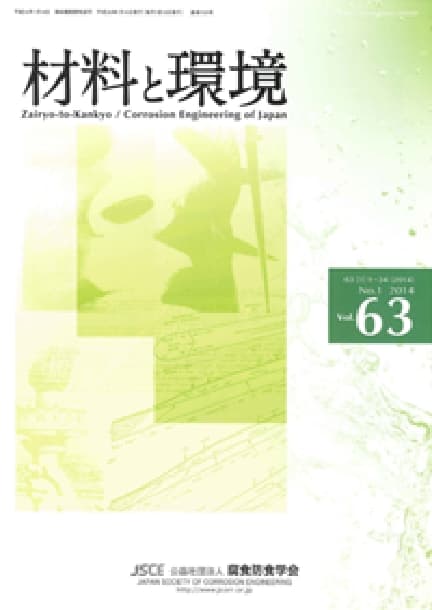- TOP
- Zairyo-to-Kankyo
- Vol. 62 (2013), No. 9
Zairyo-to-Kankyo Vol. 62 (2013), No. 9
Backnumber
-
Vol. 74 (2025)
-
Vol. 73 (2024)
-
Vol. 72 (2023)
-
Vol. 71 (2022)
-
Vol. 70 (2021)
-
Vol. 69 (2020)
-
Vol. 68 (2019)
-
Vol. 67 (2018)
-
Vol. 66 (2017)
-
Vol. 65 (2016)
-
Vol. 64 (2015)
-
Vol. 63 (2014)
-
Vol. 62 (2013)
-
Vol. 61 (2012)
-
Vol. 60 (2011)
-
Vol. 59 (2010)
-
Vol. 58 (2009)
-
Vol. 57 (2008)
-
Vol. 56 (2007)
-
Vol. 55 (2006)
-
Vol. 54 (2005)
-
Vol. 53 (2004)
-
Vol. 52 (2003)
-
Vol. 51 (2002)
-
Vol. 50 (2001)
-
Vol. 49 (2000)
-
Vol. 48 (1999)
-
Vol. 47 (1998)
-
Vol. 46 (1997)
-
Vol. 45 (1996)
-
Vol. 44 (1995)
-
Vol. 43 (1994)
-
Vol. 42 (1993)
-
Vol. 41 (1992)
-
Vol. 40 (1991)
Keyword Ranking
03 Dec. (Last 30 Days)
Zairyo-to-Kankyo Vol. 62 (2013), No. 9
Application of High Temperature Materials Thermodynamics to Room-Temperature Pourbaix Diagrams for Multi-component Systems
Harumi Yokokawa
pp. 303-309
DOI:
10.3323/jcorr.62.303Abstract
The generalized chemical potential diagram for multi-component systems at high temperatures can provide useful and crucial information in examining materials behaviors in various environments including interfaces of dissimilar materials. This approach cannot apply directly to room temperature chemistry to be analyzed using the Pourbaix diagrams. Key concepts are discussed in terms of reasonable treatments of solid-solution equilibrium in view of kinetic considerations on nucleation and diffusion which make different room temperature chemistry from that at high temperatures. New construction strategies for multi-component Pourbaix diagrams are proposed with an emphasis of congruent dissolution process. Application to electrochemical process such as lithium batteries is shown as an interesting example.
Corrosion Simulation Technology Based on Electrolyte Thermodynamics
Kohtaroh Tanaka
pp. 310-316
DOI:
10.3323/jcorr.62.310Abstract
Corrosion behavior of materials in aqueous solution can be quantitatively analyzed by simulation with electrolyte thermodynamic model, electrochemical kinetic model on material surface and mass-transfer and adsorption models between solution and material surface. This report introduces thermodynamic analysis method by real solution stability diagram, general corrosion rate estimation method by simulated polarization curves and localized corrosion susceptibility evaluation method by repassivation potential with concrete validation examples.
Development of the Identification Method of the Current from Sacrificial Anodes of Large Marine Steel Structures using Bayesian Estimation
Naoki Yoneya, Kenji Amaya, Yoshikazu Akira, Kenkichi Tashiro, Tomohiro Iida, Toru Yamaji
pp. 326-333
DOI:
10.3323/jcorr.62.326Abstract
A new method for estimating the current of sacrificial anodes and the surface potential of the structure from the potential measurement was developed. The observation equation is formed by finite element method considering the geometry of the sea structure. Since this estimation problem is ill conditioned, the Bayesian Estimation approach is employed to overcome the problem. In order to demonstrate the effectiveness and efficiency of the present method, the verification experiment was performed at the real steel structures. This method enables us to estimate the corrosion protection state of the marine steel structure with easy inspection.
Why Do Anions Inhibit or Stimulate the Anodic Process of Iron Corrosion in an Acid Solution?
Kunitsugu Aramaki
pp. 334-336
DOI:
10.3323/jcorr.62.334Abstract
It has been reported in the previous studies that anions like Cl-, Br-, and I- inhibit and those like SCN-, SH-, and S2O32- stimulate the anodic process of iron corrosion in 1 M HClO4. These effects of anions on the anodic process were interpreted on the basis of the hard and soft acids and bases principle. The former three anions classified into the soft bases suppress the anodic process by the formation of a stable adsorption bond on bare iron, a soft acid. The latter three anions of the soft and hard bases accelerate the process due to soft acid-soft base and hard acid-hard base interactions.
Readers Who Read This Article Also Read
Zairyo-to-Kankyo Vol.47(1998), No.5
Zairyo-to-Kankyo Vol.62(2013), No.12
Zairyo-to-Kankyo Vol.64(2015), No.9
Article Access Ranking
03 Dec. (Last 30 Days)
-
Perspectives on the Promising Pathways to Zero Carbon Emissions in the Steel Industry toward 2050
ISIJ International Vol.65(2025), No.2
-
Integrated Steelworks that Reduce CO2 Emissions by More Than 80% ─ Challenge for Carbon-Neutral Integrated Steelworks ─
Tetsu-to-Hagané Vol.111(2025), No.13
-
Effect of microstructural heterogeneity on fatigue limit of as-quenched low-carbon low-alloy martensitic steel
ISIJ International Advance Publication
-
Progress of Strip Casting Technology for Steel; Historical Developments
ISIJ International Vol.52(2012), No.12
-
-
Microstructures and Reduction Properties of High CaO Concentration Sintered Ore
ISIJ International Advance Publication
-
Effect of Baffles on the Mixing of Liquid and Particles in a Mechanically Stirred Vessel
Tetsu-to-Hagané Vol.90(2004), No.6
-
Corrosion Mechanism of Ag in H2S/NO2 Mixed Gas
Zairyo-to-Kankyo Vol.74(2025), No.4
-
Advanced Coil Cooling Model Incorporating Layering and Interface Effects of Strip Windings
ISIJ International Vol.65(2025), No.11
-
New Electromagnetic Flow Control System for Optimization of Molten Steel Flow in Continuous Casting Mold
Tetsu-to-Hagané Advance Publication
You can use this feature after you logged into the site.
Please click the button below.










